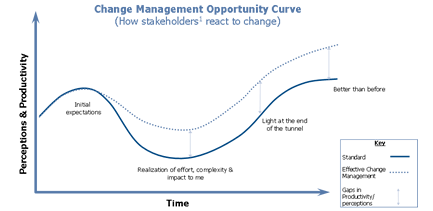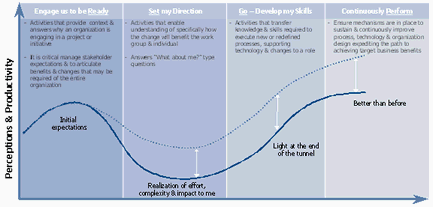| Contact Us |
|
|
Overcoming Employees Resistance to ChangeDownload a PDF of Overcoming Employees Resistance to Change.The hard facts Every year millions of dollars are spent by corporations to increase profits through the implementation of new processes, updated systems, and acquisition of companies. And every year corporations are readjusting their profit outlook due to lackluster results. Why is there such a gap between speculated profits and actual profits? It is being discovered that a large portion of this disparity is due to employees’ resistance to change. What’s making employees resist change? Even though history has shown that all business benefits sustained from a change will be derived through people, not through a network of business processes and technologies, corporations are still not addressing the impacts of change on their employees. In fact, a recent survey conducted with over 400 companies concluded that the top obstacle to a successful change program is employee resistance to change at all levels, including front-line personnel, middle management and senior management. Furthermore, studies have indicated that the change associated with an initiative or project implementation will impact how stakeholders perceive their role, which has a direct correlation to their productivity, as shown in the chart below.
In the early stages of any business transformation, large or small, people form initial expectations or impressions based upon what the benefit of the transformation will be for the organization as a whole. Once they begin to get more detail, they begin to ask how the initiative will impact their work group and them; and they begin to ask “What about me?” This is a crucial stage. If their questions are not appropriately answered, their perceptions and, in turn, their productivity will begin to spiral downward. The lack of information will cause them to fill in the blanks for themselves with information that may or may not be factual, thus creating barriers to the implementation that could be costly to overcome. If their questions are addressed effectively and they see how they will eventually fit into the solution, the risk and their perceptions are managed and in return productivity begins to increase. There are four main factors that cause employees to resist change; 1) employees are unaware of the initiative, 2) employees do not understand how the change will affect them, 3) employees are worried how the transformation may change their roles and responsibilities, 4) employees are concerned if they will be able to master the needed skills and knowledge to perform in the changed environment. It has been demonstrated that the implementation of a proven change management program, such as People & Performance Solutions change management methodology, will reduce employee resistance, as well as diminish dips in employee perception/productivity as indicated by the dashed line in the Change Management Opportunity Curve. So how do you ensure that the right employees are receiving the right message at the right time and that the right employees are prepared for what lies ahead? Engage your employees in the process through the implementation of People & Performance Solutions four stages of engagement that utilizes eight change components. The outcome is that each impacted stakeholder group is empowered to develop their own change implementation plan.
Stages of Stakeholder Engagement and Change Levers As the diagram shows below, there are four stages of engagement: : Ready, Set, Go Perform. Engage us to be Ready; Set my direction; Go – Develop my Skills; and Continuously Perform. At each stage of engagement, the stakeholder group change impacts and change components are analyzed and the appropriate change activities for that stage are determined.
The eight change components are: Executive Sponsorship & Stakeholder Management, Team Readiness, Organization Change Readiness, Communication, Organization Design and Transition, Education and Training, Engaging Ownership and Performance Readiness. Implementing the eight change components in conjunction with the stages of engagement will result in stakeholders building a comprehensive understanding of the following key aspects of managing change:
It is important to understand that managing change cannot be accomplished by only telling employees of a new initiative. There are series of activities, as highlighted, that are pertinent for preparing people in organizations to acclimate and to embrace any change. Stepping people methodically through the process will give people the opportunity to be a catalyst for change, instead of a roadblock to change.
Contact Us to learn about how People & Performance Solutions can help you with your change management needs.
|
| ©2005 People & Performance Solutions, LLC, All Rights Reserved. | Site Map |


